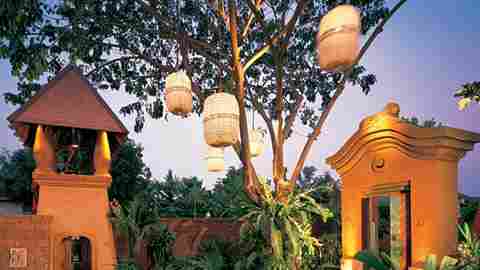Taste for the Tropics
View Slideshow

Never do anything twice. Experiment. Do weird things," says landscape designer Bill Bensley. "Once you start repeating yourself, you're through." Those are tall orders from arguably the busiest landscape designer in Asia. But as is clear from his new Bangkok residence, the California-born, Harvard-educated Bensley knows how to take his own advice. His house is dubbed Baan Botanica, in tribute to the fifteen hundred species of plants growing in its nursery and gardens. Located on the outskirts of downtown Bangkok, it is an oasis of lush tropical greenery, a delirium of texture and color and a tapestry of styles inspired by exotic, wide-ranging travels. For Bensley, who lives there with his partner, horticulturist Jirachai Rengthong, and his father, Kenneth Bensley, it is an incubator for fledgling ideas as well.
Since launching Bensley Design Studios in 1989, Bensley has created roughly one hundred resort and hotel gardens. They include the Regent, Chiang Mai (see Architectural Digest , September 1995); Rajvilas, India (see Architectural Digest , August 1998); and Novotel, Lombok (see Architectural Digest , December 1999). With offices in Bangkok and Bali, he currently has more than twenty projects on the drawing board. But unlike many Asia enthusiasts who favor an austere aesthetic, Bensley takes an extroverted, more-is-more approach. A product of southern California, he is a master of inventiveness.
His gardens are not just stage sets for the architecture they house. They are events in their own right. They have a cinematic quality, changing, as in a movie, from one self-contained scene to the next, and combining far-reaching multicultural influences with elements of fantasy. His passion for gardens dates back to early childhood, but he only stumbled upon landscape architecture in his late teens. "I was calling the fire department for a career studies class in high school, and I accidentally dialed the wrong number," he recalls. "The man who picked up the phone said he was a landscape architect. I said, What's that?' And he came over to my house and showed me slides from Knott's Berry Farm."
While at California State Polytechnic University, Pomona, Bensley won the American Society of Landscape Architects' highest honor for a student and was awarded a full fellowship to Harvard's Graduate School of Design. He moved to Asia at the urging of his friend and frequent collaborator, Thai architect Lek Bunnag, upon graduation in 1984. Five years later Bensley established his own landscape design practice in Bangkok. More recently, Bensley Design Studios has expanded its reach into the domains of architecture and interior design.
Baan Botanica represents Bensley's first foray into these new areas. He not only reinvented the house and gardens, he conceived its interiors and some of the furniture and art objects as well.
When he bought the property in 1997, it was a homely faux-colonial-style house "with a big puddle in the middle of the grounds and a lot of ratty trees around," says Bensley. By coating the original two-story structure with a mixture of rice husk and plaster, he gently augmented its original form. In what might be his most creative flourish, he used organic fertilizer—as opposed to paint or stain—to give the exterior its rusty color.
Tucked into a quiet residential street, Baan Botanica packs an immediate visual wallop. Its fanciful front entrance, a sculptural bell tower, is flanked by a laterite wall. One steps into a small courtyard paved with harlequin-patterned tiles and punctuated by a Mexican-style fountain. The courtyard, a meeting point for the two main axes of the grounds, leads to both the house and the water garden.
"Baan Botanica is a blend of things that we put together from different cultures and places," says Jirachai. "The shape of the water garden gate, for example, comes from Bali. The lion on top of it we saw in Portugal.
The symbol above the door, which means number one, is Thai. And the heavy wood doors are from China."
It is classic Bensley style to meld these elements to create something familiar but entirely new. "The fact that people still work with their hands here really enhances our ability to do this type of design," he notes.
The interior is filled with a staggering collection of objects and furniture: Pakistani chests, Afghani window frames, Indian and Indonesian doors, sculptures, and textiles and ceramics from every corner of Asia. Yet Bensley's eye favors functional, unglorified, everyday objects, such as birdcages and chicken baskets.
What originally attracted him to the house was the potential for alfresco living. The south loggia—an open-air dining area that enjoys excellent views of the small tropical garden—is now the centerpiece of Baan Botanica. It feeds into the living room, which is also known as the elephant sala, after the gold-leafed painting of an elephant hanging over the sofa. The room's natural fibers and airiness lend a casual flavor.
Dominated by hues of ocher, cinnamon and bronze, the master bedroom is warm and intimate. It is furnished with heavy wood pieces—a nineteenth-century Chinese apothecary's chest and a Burmese post office cabinet, for example—and paneled on one side with a wall from a traditional Thai house.
By contrast, the gardens are lush, densely planted and impressively versatile. They shift from style to style—elegant courtyard to Balinese water garden, party lawn to tropical swimming pool—without feeling awkward or contrived. "That's the secret—to create discrete rooms within the landscape," Bensley explains.
Bensley and Jirachai are devoted to cultivating plants. They collect sansevierias, agaves, calatheas, heliconias and plants in the ginger family. They have more than twenty-five species of plumeria, from huge white and yellow to tiny blood-red flowers. In addition, Jirachai keeps a nursery, where he breeds Aglaonema; he has developed almost two hundred new strains.
Indeed, even while Bill Bensley's design interests and projects seem to divide and multiply, it is perhaps the down-and-dirty, hands-on work of maintaining gardens that remains his real passion. "I'm a gardener first," he says, "a landscape architect second and a designer third."